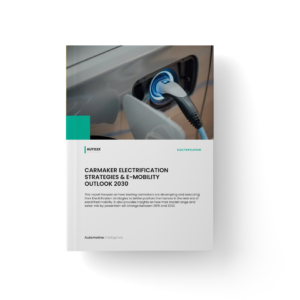Description
Batteries and Hydrogen hold a key role in the future of Automotive: sustainable and Circular
Electrification of passenger cars and commercial vehicles will play an important role on the journey towards a carbon neutral society. While battery is taking central stage, hydrogen has the potential to be an important, safe, low-carbon transport fuel, particularly for heavy-duty transport such as trucks, buses and shipping.
This report examines the impact of technology and market forces to unveil the future of battery and hydrogen mobility.
- Learn about innovative research to tackle technological challenges of cost, energy density, storage and infrastructure;
- Understand the development of regulation and policy which could remove the barrier of developing infrastructure;
- Assess the strategies of players to build strong position in future mobility.
Batteries become the cornerstone of new business models in electrification
Battery-as-a-Service, Battery-Swapping, emerge as new revenue pools for automotive players.
Web3 and Blockchain applications emerge to support transparency and traceability.
- Everledger created “EV battery digital passports” with Ford to track batteries across their lifecycle.
- Volvo and Jaguar Land Rover are among the carmakers who have already started digitalizing their supply chain using blockchain to source cobalt for EV battery cells.
Environmental regulation for Circular battery economy drives recycling and 2nd life applications
With the proliferation of electric vehicles, regulations are trying to tackle their environmental management.
- China has recently published legislation obliging battery and EV manufacturers to recycle exhausted EV batteries at the end of their first life.
- In December 2022, the US government’s Bipartisan Infrastructure Law Funding announced support for the reintegration of used batteries through recycling and reusing to meet the increasing supply chain demands and reduce dependence on imports for critical materials and components;
- Europe has introduced Circular Battery mandates with the EU Battery Directive.
Moving from a linear to a circular value chain can improve both the environmental and the economic footprint of batteries by getting more out of them while in use, and by harvesting their end-of-life value.
A plethora of technological innovations in electric vehicle batteries, business models for 2nd life and recyclability, and industry collaboration will be crucial for the shift from Low to Full Circular Mobility.
The race to replace lithium-ion batteries is on to solve range anxiety, fast-charging and affordability
Researchers in the US, Japan, China and the EU are focused on several alternatives which may not be available for more than a decade.
Tesla, Ford and VW see lithium-iron-phosphate (LFP) batteries as a cheaper alternative to cobalt as most of the world’s cobalt reserves are located in the Congo, where the mining sector is associated with human rights violations. LFPs already play a dominant role in China’s battery EV market which makes them the primary choice in the energy storage sector until at least 2030.
CATL unveiled its first-generation sodium-ion battery. Sodium is abundant, less expensive and the batteries are non-flammable, so CATL plans to ramp up production by 2023.
Start-ups aim at solving the technological challenges of EV batteries
Three market forces are driving zero-emission powertrains: regulations, innovation in batteries and fuel cells and investments in Electrification, EV Charging & Hydrogen Mobility.
Early-stage funding of Automotive start-ups shrunk from $12.2 Billion in 2021 to $10.9 Billion in 2022 and just $1.5 Billion in Q1 2023. Early-stage funding, which includes Pre-Seed, Seed, A and B Series, amounted to $24 Billion between Q1 2021 & Q1 2023.
Electric vehicles accounted for most of the funding between 2021 and Q1-2023 ($12B), followed by Mobility business models ($6B) and autonomous vehicles ($6B).
- IonQ using quantum computing for material simulation for the development of EV batteries;
- Some prominent startups working on Solid State Batteys, such as Solid Power, QuantumScape are located in the USA and they have partnerships with major carmakers such as Hyundai.
- Actify’s Program Management Software
Carmakers are introducing aggressive roadmaps for new electric vehicles to capture the rising market. According to automotive industry data, the number of programs launched by global carmakers will increase by 50% to 65% over the next three years. There is a huge wave coming at the suppliers who need to digitalize their Program Management functions to support the complexity and scalability of vehicle and parts manufacturing.
Auto2x spoke to Dave Opsahl the CEO of Actify, to understand how Actify’s software management can help suppliers overcome resource constraints and support the fast transition to electrified mobility and networked driving.
“We can automate a lot of the activity of launching a program, which today all happens manually. Our software helps suppliers communicate with their customers about Requests for Quotations (RFQ) and build. We make it possible for them to take the design information and be able to understand what’s the item at issue”, says Dave Opsahl”. Learn more here.
New battery and hydrogen hotspots emerge
Even though China dominates battery manufacturing, Europe, the US and Korea are competing to develop stronger domestic capabilities and limit their dependence on China.
Electrification Outlook: Adoption of BEVs and Hydrogen Vehicles
EVs reached more than 20% share in China & Europe in H1 2022. ICE penetration dropped to 53.8% in Europe
6.9 million EVs were sold in China in 2022, surging by 94% y-y, said CAAM
- NEV sales reached 2.5 million in China, vs. 1.1 million in Europe and 0.4m in the US in the first half of 2022.
- Electric car penetration rose to 24% in China, vs. 20% in Europe and just 6% in the US;
- Europe widens the gap compared to the US
China’s new car sales rose by 3.4% to 10.4 million in H1 2022, but NEVs saw a 107% y-y increase. China’s BEV & PHEV cars (New Energy) reached 24% market share in H1 2022, according to CAAM.
In Europe, ACEA reported that BEV penetration reached 12% while ICE’s share dropped to 53.4% in Q1-Q3 2022. Electric car sales (BEV + PHEV) reached 1.7m, or 20.4% of the mix with HEVs accounting for 23.7%.
Is Hydrogen Mobility over-hyped or at an inflection point?
Hydrogen has the potential to reach TAM of $185 Billion by 2026, vs. $671B from EVs, $200 Billion for Biofuels and just $12 Billion for Fuel cells. Hydrogen Mobility is still in its infancy but there is potential in two domains.
- Lowering the cost of Green Hydrogen below $1/kg
The European Commission states that Fuel-Cell hydrogen trucks can become cost-competitive by 2027, if hydrogen drops to €6/kg. We assess that the cost of green hydrogen is expected to see dramatic cost reductions this decade as the cost of renewable energy and electrolysers fall.
One interesting player to watch is Advanced Ionics who has developed an electrolyzer that runs at temperatures below 650 C and it is reportedly able to produce hydrogen for $0.85/kg or less.
- Commercializing eFuels and Hydrogen ICE to extend petrol & diesel
In terms of Hydrogen ICE, Toyota is making big bets not only to save the ICE but to replace EVs. We believe that in the near term, the low TCO positions H2-HPDI to be the most capital efficient means to use H2 and lower CO2 emissions from heavy duty applications.
Finally, eFuels got a shot in the arm with the latest update from the EU that could potentially allow sales of new cars with internal combustion engines after 2035 if they run only on efuels. This shows the German car industry’s lobbying power, but techno-commercial challenges remain.




